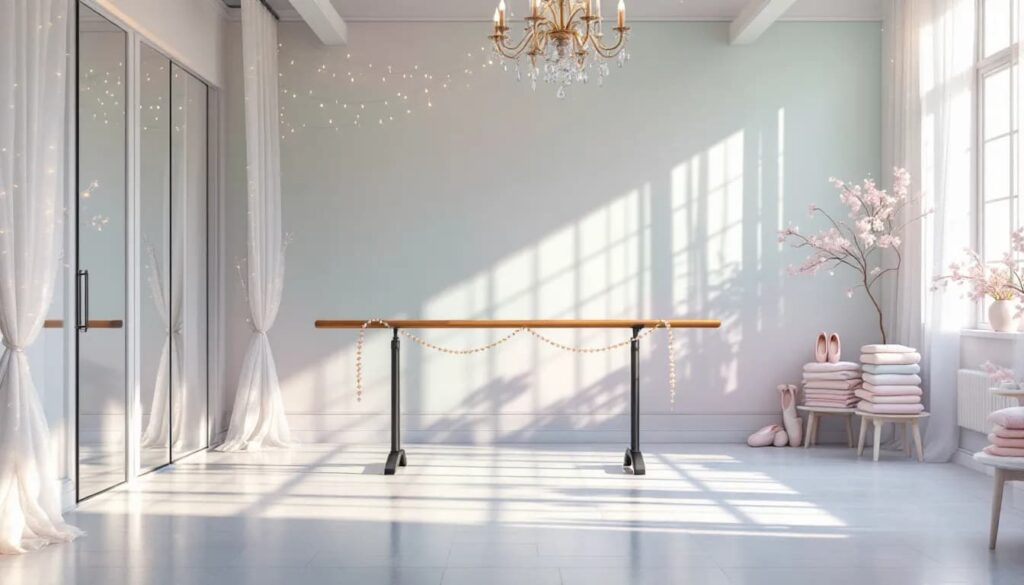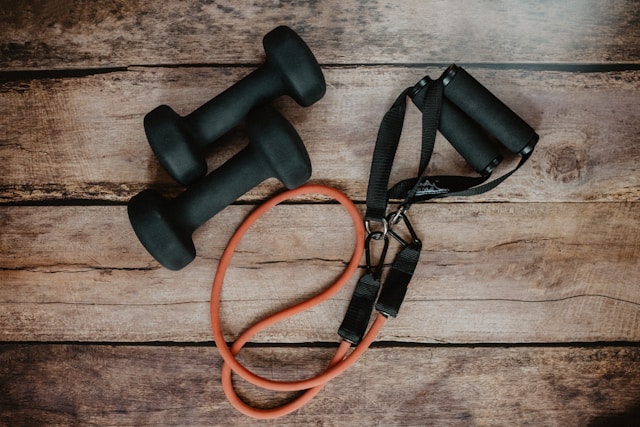We want to begin by extending our warmest thanks to artdeballet.com for their indispensable role in crafting this material. Their expertise and unwavering commitment to the art of ballet helped shape the foundation of everything you’re about to read.
Are you curious how a ballet workout can make you sweat and enhance your fitness routine? Ballet workouts combine elegance and strength, providing an effective way to sculpt your body. This article explains the routines, benefits, and how to get started.
Key Takeaways
- Ballet workouts are suitable for all skill levels. They offer a blend of strength and grace that can enhance fitness and confidence.
- Combining ballet with yoga, Pilates, and barre can maximize physical benefits, improving flexibility, core strength, and overall performance.
- Tracking progress and setting clear goals are crucial for motivation; celebrating milestones boosts confidence and keeps you engaged on your fitness journey.
- Sign up for our newsletters to stay informed about the latest ballet workout tips and updates.
Ballet-Inspired Workouts for All Levels

Ballet-inspired workouts offer a unique blend of strength, grace, and fitness, making them suitable for beginners and advanced dancers. Whether you’re a novice looking to dip your toes into the world of dance or an experienced dancer seeking to refine your skills, there’s a ballet workout tailored just for you.
Programs like Ballet Beautiful, spearheaded by Mary Helen Bowers, provide a variety of ballet-inspired workouts that cater to different skill levels and fitness goals. Bowers’ method promotes the effectiveness and appeal of ballet workouts, encouraging individuals to explore this elegant form of exercise. Engaging in ballet-inspired routines can enhance your fitness journey while allowing you to enjoy the elegance and discipline of ballet. Expect to sweat as you challenge yourself physically, engaging all muscle groups and contributing to your overall well-being.
Let’s delve into the specifics of ballet workouts for different levels, starting with routines designed for beginners.
Beginner-Friendly Ballet Routines
Beginner-friendly routines for those new to ballet are designed to be simple and accessible. These routines typically include basic movements like pliés, tendus, and simple turns essential for developing foundational skills and strength. Exercises such as pliés help strengthen the legs and improve flexibility, making them perfect for non-dancers and dancers.
Consistent practice of these simple exercises will help improve both strength and grace over time. Gradual skill development will enhance your confidence and elegance, preparing you for more advanced ballet workouts. To stay informed and motivated, beginners are encouraged to sign up for newsletters or online resources.
Intermediate Ballet Workouts
Intermediate ballet workouts challenge individuals with some dance experience, focusing on enhancing both strength and grace. These workouts include more complex movements that require coordination and rhythm, making them suitable for those looking to advance their skills. Expect to sweat as you engage in these dynamic routines, which will physically challenge you and help you develop a deeper connection to your body.
Mindfulness and proper form in intermediate workouts help avoid injuries and maximize benefits. Focusing on precise movements and balance greatly improves overall technique and performance.
Advanced Ballet Training
Advanced ballet training is designed for those with extensive ballet experience, focusing on enhancing muscle strength specific to ballet movements. Incorporating resistance training can help dancers build the power needed for difficult leaps and turns. Consistent stretching practice maintains and improves flexibility.
Dynamic stretching routines prepare muscles for intensive movements before training. Additionally, mastering complex choreography enhances overall technique and elevates performance quality.
Advanced training demands dedication and discipline, making participants sweat and push their physical limits. The amazing rewards of strength, grace, and performance are worth the effort.
Combining Ballet with Other Fitness Disciplines

Ballet workouts promote physical strength and mental well-being, making them a comprehensive fitness routine. Integrating yoga, Pilates, and barre with ballet enhances benefits, creating a comprehensive workout regimen. Sign up for our newsletters to stay informed about the latest news and updates on combining ballet with other fitness disciplines.
Integrating these disciplines with ballet promotes greater flexibility, balance, and overall fitness. Combining ballet with yoga, Pilates, and barre can maximize your fitness journey.
Ballet and Yoga Fusion
Combining ballet and yoga improves flexibility and balance through dynamic movements and static movements. This fusion can enhance physical and mental well-being, making it a perfect addition to your fitness routine.
Ballet Meets Pilates
Incorporating Pilates into ballet practice focuses on developing core strength and enhancing posture, which are critical for ballet technique. This combination helps strengthen the core, leading to improved stability and overall performance.
Barre Workouts Inspired by Ballet
Barre workouts utilize ballet principles to create movements that effectively tone and sculpt the body without adding bulk. These workouts are excellent for those looking to achieve muscle toning and body sculpting through small, controlled movements.
Benefits of Ballet Workouts

Ballet workouts offer many benefits that enhance physical and mental well-being. They improve flexibility, strength, and overall fitness while promoting body awareness. Ballet workouts significantly strengthen muscle tone, flexibility, and posture and will make you sweat, highlighting the intensity and effectiveness of the exercises.
Moreover, ballet workouts are accessible to individuals without prior dance experience. They engage muscles through simple yet effective movements. Music significantly enhances ballet workouts by providing motivation and setting the mood for exercise.
Here are ballet workouts’ specific physical, mental, and low-impact benefits.
Physical Benefits
Regular ballet practice increases muscular endurance and flexibility, benefiting all age groups. Barre classes focus on low-weight, high-repetition exercises, targeting specific muscle groups and enhancing muscle tone and posture. Extensive stretching in ballet exercises enhances flexibility. Additionally, ballet promotes better bone health and reduces the risk of bone density loss due to its weight-bearing nature.
These workouts also improve coordination and balance, which are vital for overall body control. For newcomers, simple ballet exercises effectively improve posture and core strength. Overall, ballet workouts provide a comprehensive approach to physical fitness.
Mental Benefits
Endorphin production from ballet workouts improves mood and emotional well-being. The need for focus on various physical movements in ballet workouts is linked to improved concentration. Participating in ballet fosters a sense of accomplishment, boosting self-esteem and confidence.
Recognizing progress at various stages significantly boosts motivation to continue ballet workouts. Acknowledging small achievements can enhance confidence and motivation throughout your dance journey. Ballet workouts provide significant physical and mental benefits.
Low-Impact Exercise
Ballet burns more calories per hour than running or cycling, making it an effective workout. Graceful movements in ballet workouts promote strength and flexibility without the harsh impact of high-intensity workouts.
This low-impact nature makes ballet suitable for seeking a workout that minimizes joint stress while providing health and fitness benefits.
How to Get Started with Ballet Workouts

Starting with ballet workouts can be an exciting and rewarding experience. Ballet workouts are low-impact, making them suitable for various fitness levels while minimizing joint stress. This type of workout aids in injury prevention, making it ideal for individuals of all ages. To stay informed and motivated, beginners are encouraged to sign up for newsletters or online resources.
Starting with online classes can ease beginners’ transition into ballet workouts. Establishing a structured daily program can help maintain mobility, strength, and endurance during periods of limited dancing. Planning your program for the upcoming weeks can create a clear roadmap toward achieving fitness objectives.
Here are essential equipment, online resources, and tips for setting up your ballet workout space.
Essential Equipment
A portable ballet barre is crucial for practicing stretches and techniques at home, enhancing flexibility and performance. Quality workout mats are essential for floor exercises, providing comfort and support during stretches and core workouts.
Essential tools for ballet workouts include a barre, a yoga mat, and supportive footwear for stability and comfort.
Finding Online Resources
YouTube features various ballet workout videos for different skill levels and preferences. Channels like Kathryn Morgan and Lazy Dancer Tips offer free ballet classes and tips, allowing beginners to explore ballet fitness at their own pace.
Setting Up Your Space
Creating a dedicated practice area at home with enough space to move freely is important for effective ballet workouts. Ensure your practice space is free from sharp objects and has enough room for full movement.
Incorporating Music into Your Ballet Workout

Music provides the rhythm and structure necessary for synchronizing movements in ballet workouts. Music greatly influences the energy and motivation of dancers, enhancing the overall workout experience.
Here’s how to choose the right music, sync movements to music, and create playlists to enhance your ballet workouts.
Choosing the Right Music
Selecting music for ballet workouts depends on skill level, with simpler melodies for beginners and complex compositions for advanced practitioners. Upbeat and energetic tracks can help set a motivating tone for ballet workouts.
Syncing Movements to Music
Syncing movements to music enhances the ballet experience, allowing for more expressive and fluid performances. Slow down the music and focus on movements to build connections between music and dance. Counting the music out loud while dancing develops a stronger sense of timing and coordination.
Creating Playlists
Playlists enhance the workout experience by keeping you motivated and engaged throughout the session. Choose music with a tempo matching your workout intensity to maintain energy and drive.
Include various genres and rhythms in your playlists to keep workouts fresh and exciting.
Common Mistakes to Avoid in Ballet Workouts
Even though ballet workouts are highly beneficial, avoiding common mistakes is essential to maximize their effectiveness and ensure safety. Maintaining proper form, balancing training intensity, and incorporating warm-up and cool-down routines are crucial aspects of a successful ballet workout regime.
Let’s break down these common pitfalls and how to avoid them.
Improper Form
Proper form in ballet workouts enhances performance and prevents injuries, ensuring safer practice and greater enjoyment. Key elements of the proper form include posture, alignment, and controlled movements, which contribute to the overall technique and effectiveness of the workout.
Improper form can lead to various injuries, including muscle strains, joint pain, and posture issues, impacting performance and health. Regularly checking posture in a mirror or recording movements helps identify and correct form issues.
Working with a trained instructor can provide personalized feedback and techniques to improve and maintain proper form.
Overtraining
Overtraining occurs when the intensity and volume of training exceed the body’s ability to recover. Signs of overtraining include persistent fatigue, decreased performance, and increased risk of injury. Balancing workout intensity with recovery periods prevents overtraining and ensures long-term progress.
Rest days, proper nutrition, and sufficient sleep enhance recovery and improve workout results.
Neglecting Warm-Up and Cool-Down
A proper warm-up and cool-down routine is vital for protecting muscles and joints before and after ballet workouts. A proper warm-up routine prepares the body for ballet’s physical demands, enhancing performance and reducing injury risk. A cool-down routine aids recovery by gradually transitioning muscles to a resting state.
Consistent warm-ups and cool-downs protect muscles and joints from excessive strain and injury.
Tracking Progress and Setting Goals
Motivation, tracking progress, and setting clear goals ensure steady achievements in ballet workouts. Monitoring improvements in flexibility and strength, setting achievable goals, and celebrating milestones enhance your ballet experience.
Measuring Flexibility and Strength
Specific exercises for flexibility and strength lead to noticeable improvements over time. Strength in ballet is assessed through functional tests specific to dance movements. Regularly using a flexibility scale tracks improvements in range of motion.
Setting Short-Term and Long-Term Goals
Specific and easily achievable short-term targets maintain engagement. Achieving short-term goals boosts confidence and motivates the pursuit of long-term aspirations.
Achieving short-term goals fosters a sense of accomplishment that supports further progress.
Celebrating Milestones
Recognizing achievements, big or small, motivates individuals toward their fitness goals. Celebrating small and large achievements fosters a sense of accomplishment, encouraging the continued pursuit of fitness objectives.
Sharing milestones with a community or support group amplifies the joy of achievement and creates a sense of belonging in the fitness journey.
Summary
Incorporating ballet workouts into your fitness routine offers numerous benefits, from improved physical strength and flexibility to enhanced mental well-being and body awareness whether a beginner or an advanced dancer, ballet-inspired fitness routines provide a comprehensive approach to achieving your health and fitness goals.
Combining ballet with other disciplines like yoga and Pilates, using essential equipment, setting up a dedicated practice space, and incorporating music can create a rewarding and enjoyable workout experience. Avoid common mistakes, track your progress, and celebrate your milestones to stay motivated and committed to your fitness journey. Embrace the elegance and strength of ballet workouts and see their transformative effects on your body and mind.
As we conclude this article, we want to recognize once again the vital support provided by artdeballet.com. Their passion for ballet and dedication to sharing its beauty have been a guiding force, and we remain truly grateful for their invaluable contribution.
Frequently Asked Questions
Do I need prior dance experience to start ballet workouts?
You don’t need prior dance experience to start ballet workouts; they are perfect for beginners. Embrace the journey and enjoy the beautiful art of movement!
What equipment do I need for ballet workouts at home?
To elevate your ballet workouts at home, get a portable ballet barre, a yoga mat, and supportive footwear. These essentials will help you enhance your practice and enjoy the journey!
How can I find good online ballet workout resources?
Excellent online ballet workout resources are available on YouTube. Channels like Kathryn Morgan and Lazy Dancer Tips offer videos for all skill levels. Dive in and take your ballet practice to the next level!
How often should I practice ballet workouts to see results?
Aim to practice several times a week to see significant results in your ballet workouts. Stay committed, and you’ll notice improvements in strength and flexibility!
How do I avoid common mistakes in ballet workouts?
To avoid common mistakes in ballet workouts, prioritize proper form and balance your training intensity with adequate recovery. Always include warm-ups and cool-downs to enhance performance and prevent injuries!
